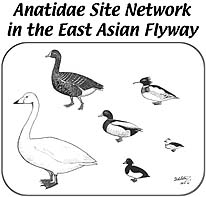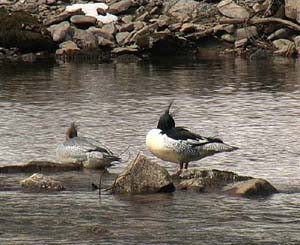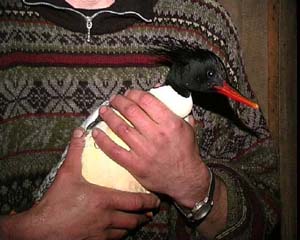|
For more information contact:
Lena-Delta State Reserve
Contact: Dr.Diana Solovieva, Ornithologist, Fiodorova Street, 28, Tiksi, Yakutia, 678400, Russia. TEL +7 41167 53939 / dianaⓐds3902.spb.edu.
|
|
|
|
References
|
* | Anet Newsletter No.3: PDF file (560KB) |
|
The Scaly-sided, or Chinese, Merganser Mergus squamatus is among rarest seaducks of Asia. The species is considered as vulnerable under the IUCN legislation. The estimation of world population varies from pessimistic 2,000 to the optimistic 10,000 birds, which are both based on the indirect data. Population trend is uncertain with expressed decline during decades of 60-80th. Most of the breeding area is situated in the South of Russian Far East and the North of China. Present project have been started in 2000 and aims to investigate factors, affecting Scaly-sided Merganser population in Russia, in order to improve conservation efforts. Project team worked on the both slopes of Sikhote-Alin Range, Primorye, Russia. Forty nine of artificial nest boxes were placed on the banks of following rivers, Avvakumovka, Kievka, Krasnaya, Iman (Bol'shaya Ussurka), Lazovka, Margaritovka, and Mineral'naya. Artificial nests program aims to investigate the influence of rivers' deforestation on breeding density and distribution of this rare duck. The results of the survey seemingly indicated an increasing of Scaly-sided Merganser population. Maximum breeding pair densities were 0,3 -- 0,4 pairs/km of river, with more than twenty rivers have been surveyed. For some rivers the breeding density of Scaly-sided Merganser was 3 -- 4 times higher, than in 1980s. Disturbance by human was found to affect the time budget of breeding pairs of Scaly-sided Merganser, what was resulted in extra flights and alerting. The best method to catch breeding Scaly-sided Merganser is seemingly the mist net trapping in twilights. A pair was ringed for the first time in the world. Project was sponsored by Lundi Co, Verl, Germany and WWT, Slimbridge, UK.
|


